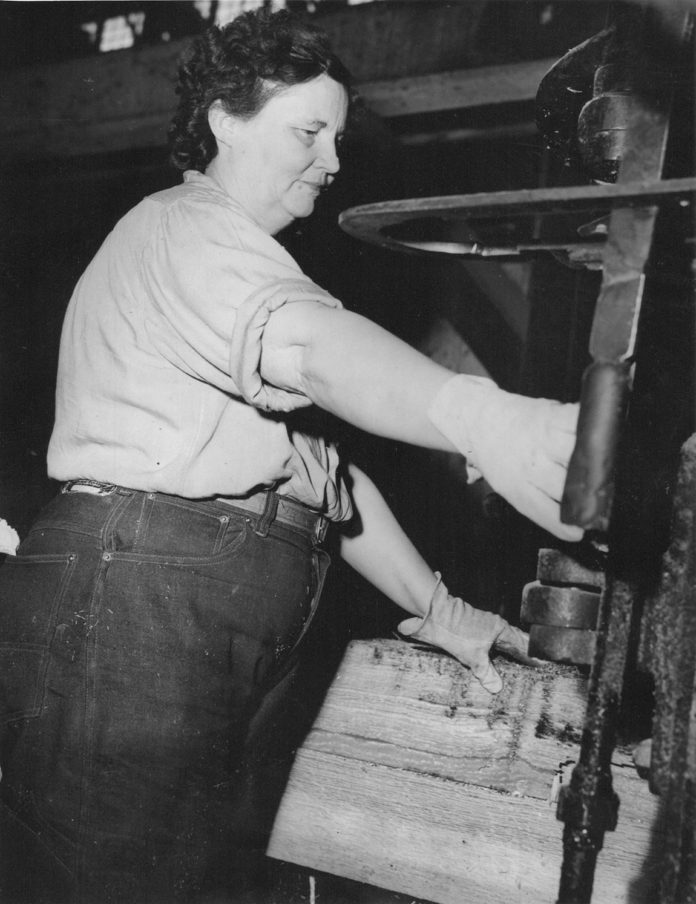After the U.S. entered World War II following the Japanese attack on Pearl Harbor, 16 million Americans joined the military, and 98% of them were men. As business and industry geared up to support the war effort, they faced severe labor shortages. In response more than six million women took wartime jobs in factories; three million volunteered with the Red Cross; and 400,000 enlisted for non-combat duties in the Army WACs, Navy WAVES, and other military efforts.
The most famous of factory women was Rosie the Riveter, a cultural icon illustrated as a woman in a red scarf and blue work-shirt showing off her bicep while mouthing the phrase, “We can do it!” At the White River Mill near Enumclaw the real Rosie was Ada Moultrie, called ‘Grandma of the Gang Saw.’ In a saw mill, the gang saw was a large circular, rotating metal blade with sharp teeth capable of reducing giant old-growth logs into manageable sizes, called cants that were further sawn into dimensional lumber.
Ada Manila Palmer was born in 1898 in Dempsey, Idaho, now called Lava Hot Springs. At age 15, Ada married Clarence Moultrie in 1914 in Salt Lake City, listing her age on the marriage license as 18. Over the next 25 years, the couple lived in 16 different locales where Clarence worked as a farm laborer and Ada bore 14 children, the oldest of whom died in 1938. By 1943, at the height of the war effort, the Moultrie family was living in Wilkeson and Ada found work at the Hanson family’s White River Lumber mill, just east of Enumclaw.
Shown here in this August 2, 1943 photo, Ada Moultrie operates mill machinery around the gang saw. She was 45 at the time. A Tacoma News Tribune story by Jim Stevens appeared later that month in which the reporter detailed Ada’s dedication to work. “She keeps house for six, milks three cows twice-a-day, makes her own butter, does all the family wash, works a victory garden, drives 11 miles to work, puts in eight hours on a gangsaw, drives home again – six days a week –and provides transportation for two other workers besides. All in all, Mrs. Moultrie gets in 14 hours of work a day.”
News of a Grandma on the gang saw reached readers far and wide. The back of this photo provided by JoAnne Matsumura, an Issaquah historian and collector, notes that it comes from the New York Bureau. A Seattle Times news section called “Hot off the Wire!” records Mrs. Ada M. Moultrie, Lumber Jill, as the KIRO radio 5 p.m. side-light narrated by Bob Nichols on Tuesday for the week ending Sunday, June 10, 1945.
As soldiers and sailors began returning from oversee stations at war’s end, men began replacing women and many wartime Rosies returned to their previous domestic roles. But not Ada. By 1950, the Moultrie family had moved to Cowlitz County in southwest Washington where Ada was working as a restaurant cook. Her husband, Clarence died in 1958, and Ada remarried Lester Grant Shambow and took his last name. Ada (Palmer, Moultrie) Shambow passed away in November 1982 in Vancouver, Washington. She was 84 years old and a member of the third ward of the Mormon Church and part of their Relief Society.
‘Grandma of the Gang Saw’ left a large and living legacy. At the time of her death, 11 of her 13 children were still living, as well as 58 grandchildren, 94 great-grandchildren, and seven great-great grandchildren. Information about the life Ada Moultrie was provided by Donna Brathovde, an amateur family historian who does genealogical research and lives in Ravensdale.








